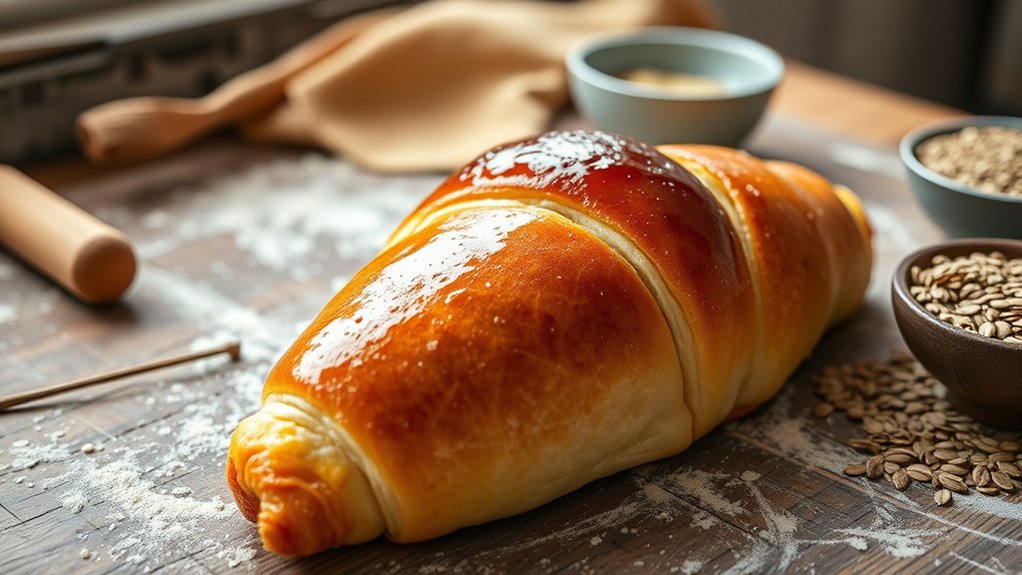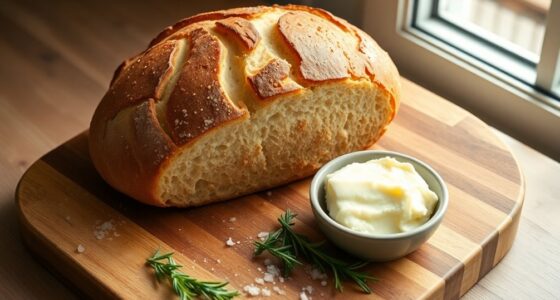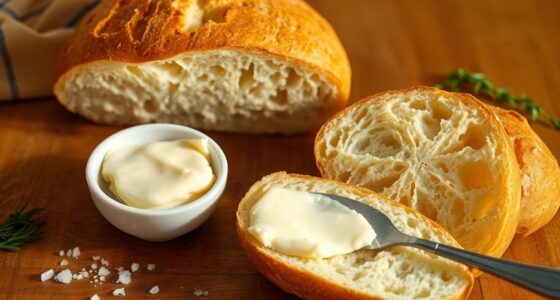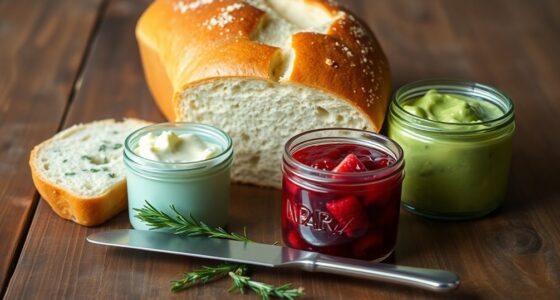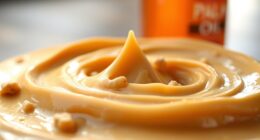To make healthier Danish pastries with whole-grain flour, choose varieties like spelt, wheat, or rye to balance flavor and gluten strength. Incorporate finer ground grains, adjust hydration, and extend fermentation to enhance texture and flavor. Use techniques like gentle folding and proper layering to achieve flakiness. Adding nuts, seeds, or spices can boost nutrition and taste. For detailed tips and tricks, continue exploring ways to perfect your whole-grain Danish dough while keeping it delicious.
Key Takeaways
- Use a blend of whole-grain flours like wheat, spelt, or rye to balance flavor, nutrition, and gluten development.
- Incorporate vital wheat gluten and adjust hydration to maintain dough elasticity and airy texture.
- Extend fermentation times to enhance flavor complexity and gluten strength without sacrificing taste.
- Add natural flavor enhancers such as spices, citrus zest, or nuts to boost taste and nutritional value.
- Handle dough gently, keep ingredients cold, and bake at proper temperatures to ensure flaky, delicious pastries with healthier ingredients.
Understanding the Benefits of Whole-Grain Flour in Pastry Making
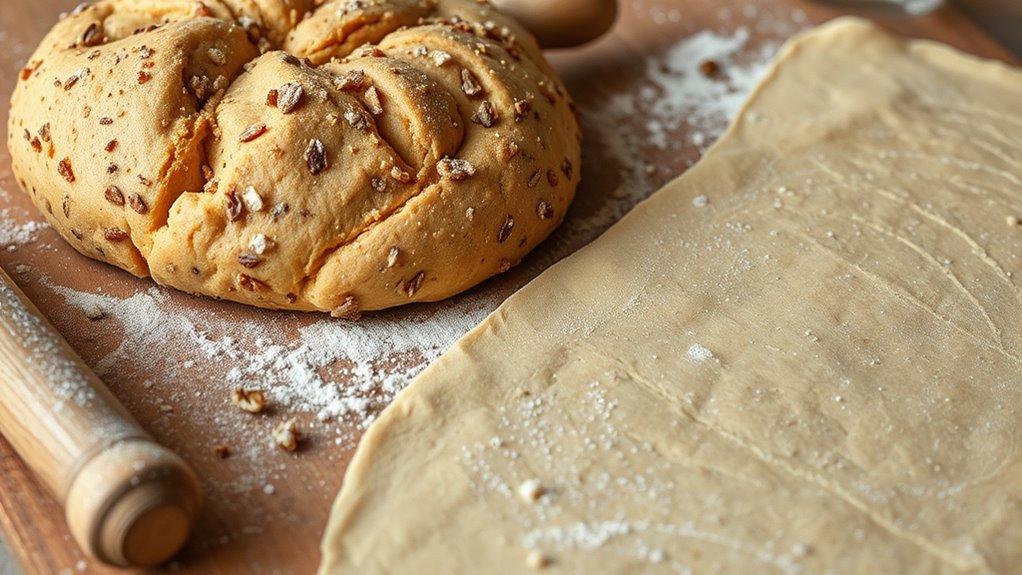
Using whole-grain flour in pastry making offers several notable benefits that can elevate your baked goods. One key advantage is improved gluten development, which helps create a stronger, more elastic dough, leading to better structure and chewiness. Whole grains contain more fiber and nutrients, enhancing the nutritional profile of your pastries. Additionally, whole-grain flours can influence fermentation techniques, as their natural enzymes and nutrients promote active fermentation. This results in a richer flavor and improved dough rise. You’ll also notice a nuttier, more complex taste compared to refined flours. While handling whole-grain dough may require some adjustments, such as longer kneading or fermentation times, the end product benefits from increased texture, flavor, and healthfulness. Incorporating automation in baking processes can further streamline your workflow and ensure consistent results. These qualities make whole-grain flour an excellent choice for elevating your pastry game.
Choosing the Right Whole-Grain Flours for Danish Dough

Choosing the right whole-grain flours can considerably affect your Danish dough’s texture and flavor. Different varieties offer unique nutritional benefits and baking qualities, so selecting the best one depends on your desired outcome. Understanding these options helps you craft a healthier, more satisfying pastry. Incorporating nutrient-rich ingredients like whole grains can also enhance the health benefits of your baked goods.
Whole-Grain Flour Varieties
Selecting the right whole-grain flours is essential for achieving the perfect texture and flavor in Danish dough. Different grain types, such as wheat, spelt, or rye, influence gluten development, which is key to a good rise and structure. Wheat flours generally provide stronger gluten networks, making them ideal for pastries, while rye offers a denser crumb with a distinct flavor. Spelt strikes a balance, with moderate gluten potential and a nutty taste. When choosing, consider how each grain type affects gluten formation and whether it aligns with your desired dough elasticity. Experimenting with blends can help you find the ideal combination for a healthier, flavorful Danish that still rises well and maintains its characteristic flaky layers. Additionally, understanding the gluten potential of each grain can guide you in selecting the best flour blend for your baking needs.
Impact on Texture
The type of whole-grain flour you incorporate directly influences the final texture of your Danish dough. Different grains contribute unique grain textures, affecting how the dough feels and behaves. For example, whole wheat flour tends to create a denser, coarser mouthfeel, while spelt or rye can add a slightly softer, more tender bite. The grain texture impacts not only the dough’s structure but also its overall mouthfeel, influencing how enjoyable it is to eat. Choosing a flour with a finer grind can help maintain a light, flaky pastry, while coarser options might add a rustic, hearty quality. Additionally, personal development techniques like mindfulness can help bakers stay present and attentive during the kneading process, ensuring the perfect texture. By selecting the right whole-grain flour, you can balance health benefits with a satisfying, appealing texture that complements the rich layers of your Danish pastry.
Nutritional Benefits
Ever wondered how to boost the nutritional profile of your Danish dough? Choosing the right whole-grain flours can substantially enhance fiber content and antioxidant levels in your pastries. Whole grains like spelt, rye, or einkorn are rich in fiber, which supports digestion and helps you feel fuller longer. They also contain antioxidants that combat oxidative stress, promoting overall health. Opting for minimally processed flours preserves these benefits, making your baked goods more nutritious without sacrificing flavor or texture. Incorporating a variety of whole grains adds diverse nutrients, ensuring you get a broad spectrum of health benefits. By selecting the right whole-grain flours, you transform your Danish pastries into a wholesome treat that’s as nourishing as it is delicious.
Adjusting Recipes for Texture and Flavor Balance
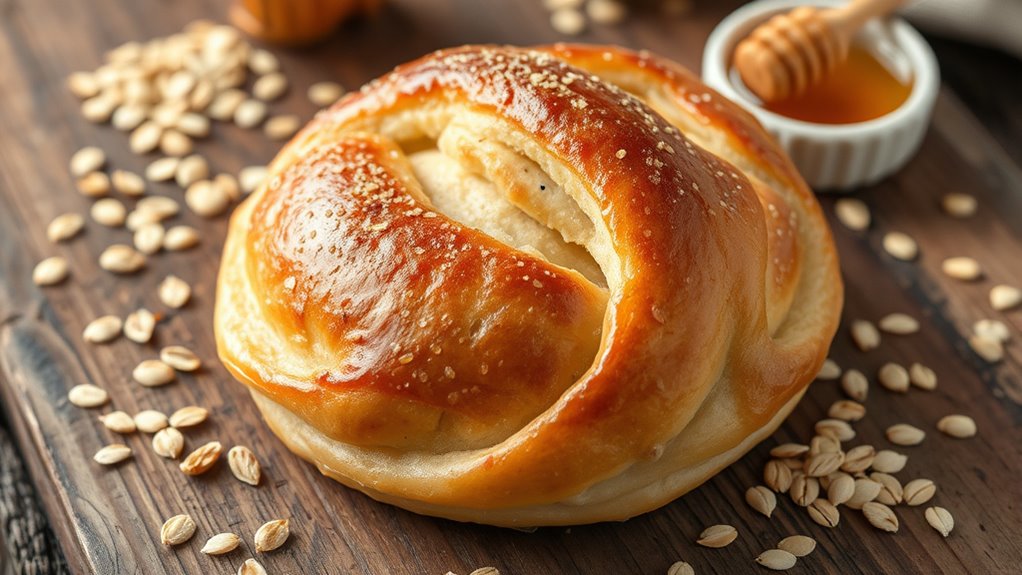
To get the perfect texture and flavor, you need to adjust your recipe carefully. You can balance the whole grain content to improve tenderness, while adding moisture helps keep the dough soft. Don’t forget to tweak sweetness and flavor to match your desired taste profile. Incorporating techniques from ethical hacking such as thorough reconnaissance can help you understand how different ingredients interact, ensuring your pastry turns out just right.
Balancing Whole Grain Content
How can you strike the right balance between whole grain and refined flour to achieve the ideal texture and flavor in your Danish dough? The key is to gradually increase whole grain content while monitoring gluten development and fermentation timing. Too much whole grain can hinder gluten networks, leading to dense pastries, so adjust gradually. Pay attention to dough consistency and allow longer fermentation times to enhance flavor and gluten strength. Incorporate these strategies:
- Use a blend of whole grain and refined flours initially
- Extend fermentation to improve flavor and gluten structure
- Incorporate vital wheat gluten if needed
- Adjust hydration levels for maximum texture
- Test small batches to find the perfect balance
Enhancing Moisture Levels
Adjusting moisture levels is essential for achieving the desired texture and flavor in your Danish dough. Proper moisture retention ensures your pastry stays tender and flaky, preventing it from drying out during baking. To enhance dough hydration, consider adding slightly more liquid ingredients, like milk or water, especially when working with whole grains that absorb more moisture. You can also incorporate ingredients such as yogurt or a small amount of butter to boost moisture retention. Keep in mind that overhydration can make the dough sticky and difficult to handle, so adjust gradually. By fine-tuning these factors, you’ll create a dough with ideal moisture levels, resulting in pastries that are moist, flavorful, and irresistibly tender. For best results, understanding the absorption properties of whole grains can help you tailor moisture adjustments more precisely.
Adjusting Sweetness and Flavor
Balancing sweetness and flavor in your Danish dough is key to achieving a harmonious taste that complements the flaky texture. Small sweetness adjustments can prevent overpowering the whole-grain flavor while enhancing natural notes. To boost flavor, consider adding subtle extracts like vanilla or almond, or incorporating spices such as cinnamon or cardamom. Tasting as you go helps you fine-tune sweetness levels for your desired profile. Remember, a little goes a long way with flavor enhancement—avoid over-sweetening or masking the whole-grain richness.
- Experiment with natural sweeteners like honey or maple syrup
- Use citrus zest for a bright flavor boost
- Incorporate aromatic spices for depth
- Balance sweetness with a touch of salt
- Taste frequently to perfect the harmony
Techniques for Incorporating Whole Grains Into Traditional Danish Dough
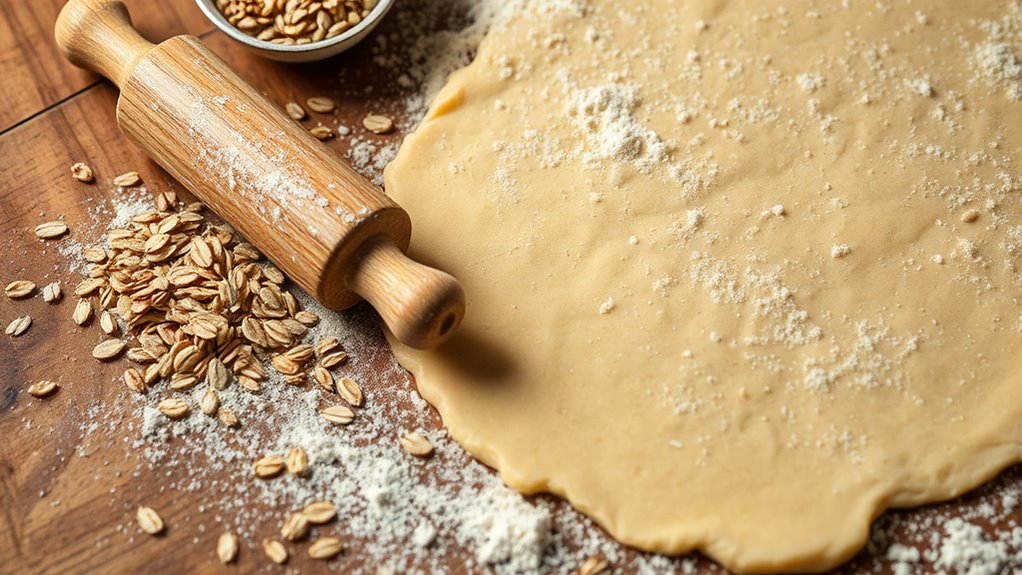
Incorporating whole grains into traditional Danish dough requires careful technique to maintain its delicate texture and flavor. To achieve proper gluten development, start by milling the whole grains finely to ensure they integrate smoothly into the dough. This helps preserve the dough’s elasticity and structure. Adjust your fermentation techniques by allowing extra fermentation time, as whole grains can slow down yeast activity. Using slightly warmer water can also help activate the gluten network and enhance fermentation. Incorporate a small amount of vital wheat gluten if needed, to improve dough strength. Be mindful not to overmix, which can break down gluten strands. Additionally, selecting natural materials like linen or wood for your mixing tools can help maintain the integrity of the dough during preparation. With these techniques, you’ll successfully blend whole grains into classic Danish pastry, maintaining its lightness and flaky layers.
Tips for Achieving Flakiness and Layers With Whole-Grain Ingredients
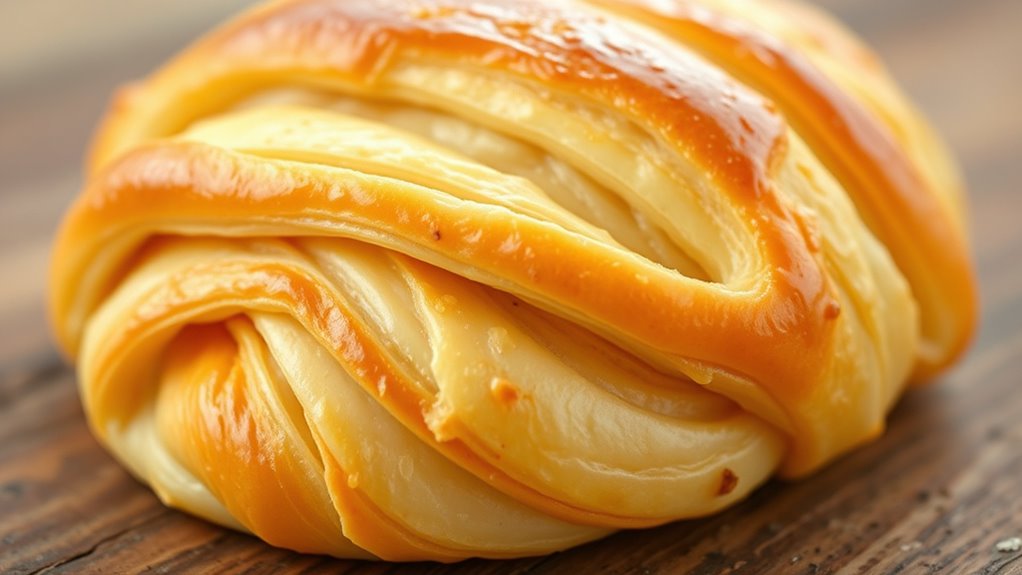
To achieve the signature flakiness and layered structure in whole-grain Danish pastries, focus on handling the dough gently and precisely. Proper gluten development is key—avoid overworking the dough to keep layers distinct and tender. Keep ingredients cold to prevent gluten from becoming too elastic, which can hinder layering. Incorporate layers through careful rolling and folding, ensuring even pressure without smashing the dough. Rest the dough adequately between folds to relax gluten, enhancing both flakiness and flavor. Using fine whole-grain flour can improve texture without sacrificing taste. Additionally, understanding digital literacy can help you access online tutorials and resources to perfect your pastry techniques.
Handle dough gently, keep ingredients cold, and fold carefully for flaky, layered whole-grain Danish pastries.
- Use cold ingredients and tools for better layering
- Fold dough multiple times, but gently
- Keep dough chilled during shaping
- Avoid over-rolling to preserve layers
- Incorporate small amounts of fat for flavor enhancement
Baking and Storage Tips for Whole-Grain Danish Pastries
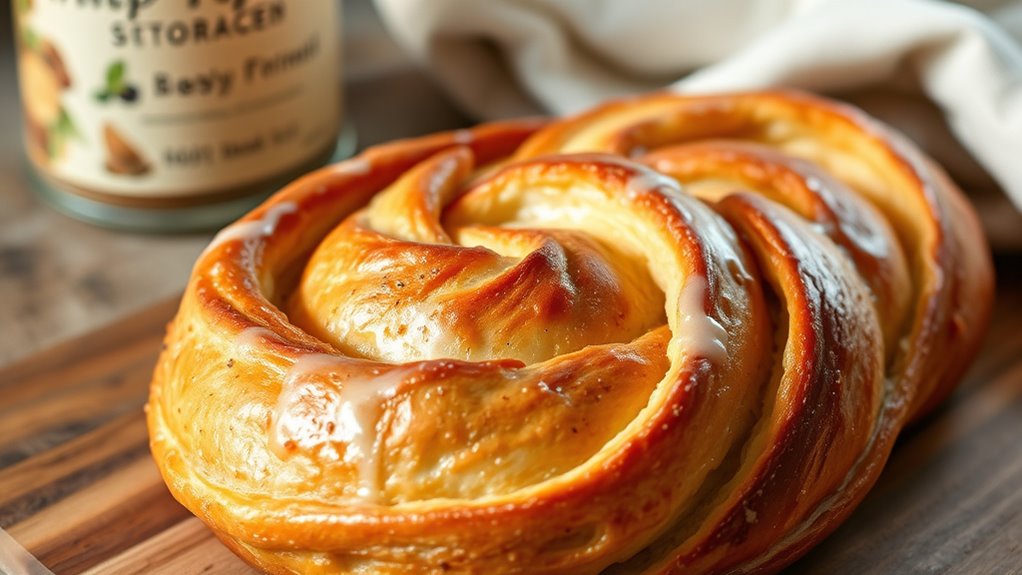
Proper baking and storage are essential to preserve the flaky layers and fresh flavor of whole-grain Danish pastries. To guarantee ideal gluten development, bake at the right temperatures—usually between 375°F and 400°F—so the layers rise properly without burning. Use an oven thermometer to maintain consistent heat, which helps achieve even baking and a crisp exterior. Once baked, let the pastries cool completely before storing to prevent moisture buildup. For storage, keep them in an airtight container at room temperature for up to two days, or freeze for longer freshness. When reheating, use a preheated oven at 350°F for 10 minutes to restore crispness without compromising the layers. Proper baking temperatures and storage practices keep your pastries delicious and flaky. Implementing precise temperature controls is vital in ensuring the pastries maintain their structure and quality during baking and storage.
Creative Variations to Enhance Nutritional Value and Taste

Adding nutritious ingredients and flavor-enhancing components can transform your whole-grain Danish pastries into healthier, more exciting treats. By incorporating simple nutritional tweaks, you boost the pastry’s health benefits without sacrificing flavor. You might add chopped nuts for crunch, or use dried fruits for natural sweetness. Spices like cinnamon or cardamom can elevate taste while offering antioxidants. Flavor enhancements such as vanilla extract or citrus zest add depth and freshness. Consider mixing in seeds like flax or chia for extra fiber and omega-3s. These creative variations make your pastries more nutritious and appealing, encouraging healthier eating habits. Try these ideas to customize your Danish and enjoy a perfect balance of taste and wellness:
- Chopped nuts or seeds
- Dried fruits or fresh berries
- Spices like cinnamon or ginger
- Citrus zest or vanilla extract
- Incorporating superfoods like flax or chia
- Exploring tableware options to serve your baked treats beautifully
Frequently Asked Questions
How Does Using Whole Grains Affect Danish Dough Shelf Life?
Using whole grains in Danish dough can slightly reduce shelf life because it affects grain preservation and mold resistance. Whole grains contain more oils and moisture, which may promote mold growth and spoilage faster. To combat this, you should store your dough properly, keep it airtight, and consider adding natural preservatives. This way, you prolong freshness while maintaining the health benefits of whole grains without sacrificing taste.
Can I Substitute All-Purpose Flour With Whole Grain in Existing Recipes?
Think of your recipe as a delicate dance; substituting all-purpose flour with whole grain is like adding new steps. You can swap in whole grain, but you’ll need to adjust flour ratios to maintain texture and structure. Start by replacing half, then gradually increase. This grain substitution adds hearty flavor and nutrition, ensuring your pastries stay tender and delicious without sacrificing that irresistible Danish charm.
Are There Specific Toppings or Fillings That Complement Whole-Grain Danish Pastries?
You’ll find that fruit fillings like berries or apples pair beautifully with whole-grain Danish pastries, adding natural sweetness and moisture. Nut toppings, such as almonds or walnuts, provide a satisfying crunch and complement the hearty flavor of the whole grains. Experiment with these options to enhance your pastry’s flavor and texture, creating a delicious balance that highlights the wholesome nature of your healthier Danish treats.
How Do I Prevent Whole Grains From Making the Dough Too Dense?
Ever wondered how to keep your pastry light with whole grains? To prevent dense grain texture, focus on proper gluten development—knead the dough just enough to strengthen the gluten network without overworking it. Incorporate essential wheat gluten or use a slightly higher hydration level to improve elasticity. These steps help you achieve a tender, flaky crust while still enjoying the health benefits of whole grains.
What Are Some Common Mistakes to Avoid When Baking Whole-Grain Danish Pastries?
When baking whole-grain Danish pastries, avoid overworking the dough, which can make it tough and dense. Also, guarantee even mixing of ingredients to prevent inconsistencies that affect texture and rise. Don’t rush the process; handle the dough gently and mix thoroughly but carefully. These mistakes can compromise your pastry’s quality, so stay attentive and follow your recipe closely to achieve flaky, flavorful results.
Conclusion
By swapping traditional flour for whole-grain in your Danish dough, you’re like an artist adding vibrant colors to a familiar masterpiece. With the right techniques and a little experimentation, you can craft pastries that are both healthier and irresistibly flaky. Embrace the process, enjoy the rich flavors, and watch your baking elevate to new heights. After all, good food is like a warm hug—comforting, nourishing, and worth every effort.
